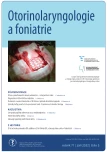-
Medical journals
- Career
Experience with awake craniotomy (performed in University Hospital in Ostrava) from the perspective of speech and language therapist
Authors: M. Kaniová 1,2; Š. Reguli 3,4; Švédíková V. 1; P. Hanzlíková 5,6; Karol Zeleník 1,7; Pavel Komínek 1,7
Authors‘ workplace: Klinika otorinolaryngologie a chirurgie hlavy a krku, FN Ostrava 1; Katedra ošetřovatelství, LF, Ostravská univerzita v Ostravě 2; Neurochirurgická klinika, FN Ostrava 3; Katedra chirurgických oborů, LF, Ostravská univerzita v Ostravě 4; Ústav radiodia gnostický, FN Ostrava 5; Ústav zobrazovacích metod, LF, Ostravská univerzita v Ostravě 6; Katedra kraniofaciálních oborů, LF, Ostravská univerzita v Ostravě 7
Published in: Otorinolaryngol Foniatr, 71, 2022, No. 3, pp. 141-146.
Category: Original Article
doi: https://doi.org/10.48095/ccorl2022141Overview
Introduction and aims: An awake craniotomy is one of the newly introduced procedures for brain tumor surgery. It is a brain operation where speech and language functions are monitored by a clinical speech therapist with the active participation of the patient who is awake during the procedure. The aim of such an operation is to preserve the speech and language functions of the patient as well as resection of the brain tumor to the greatest possible extent. This paper summarizes the current experience and knowledge of awake craniotomy at the University Hospital in Ostrava. Methodology: Retrospective evaluation of the success of performed awake craniotomies with extirpations of tumors located in eloquent regions of the brain. The criterion for the success of awake craniotomy was the preservation of patient’s speech and language skills after surgery compared to their condition before surgery. Description of procedures, preoperative examinations, and intraoperative testing by a clinical speech therapist. Results: By comparing the results of testing speech and language functions in a group of 54 patients operated between 2013 and 2021 before and after awake craniotomy, it was found that in 40 of 54 patients there was no deterioration of speech and language functions after surgery. From a speech therapy perspective, this is a 74% success rate. Conclusion: Awake craniotomy is a new procedure introduced during brain glioma operations in eloquent regions of the speech zones. The method contributes significantly to the preservation of the patient’s speech and language competences and thus to the preservation of his quality of life.
Keywords:
awake craniotomy – language functions – clinical speech therapist
Sources
1. Neubauer K. Afázie. In: Neubauer K et al. Kompendium klinické logopedie. Praha: Portál 2018.
2. Duffau H, Capelle L, Sichez N et al. Intraoperative mapping of the subcortical language pathways using direct stimulations. An anatomofunctional study. Brain 2002; 125(Pt 1): 199–214. Doi: 10.1093/ brain/ awf016.
3. Perry A. Pathology of low-grade gliomas: an update of emerging concepts. Neuro Oncol 2003; 5(3): 168–178. Doi: 10.1215/ S1152851 702000443.
4. Reguli Š, Lipina R, Hrbáč T. Neurochirurgická léčba mozkových nádorů. Onkologie 2011; 5(2): 72–74.
5. Hervey-Jumper SL, Berger MS. Technical nuances of awake brain tumor surgery and the role of maximum safe resection. J Neurosurg Sci 2015; 59(4): 351–360.
6. Morshed RA, Young JS, Lee AT et al. Clinical Pearls and Methods for Intraoperative Awake Language Mapping. Neurosurgery 2021; 89(2): 143–153. Doi: 10.1093/ neuros/ nya 440.
7. Cséfalvay Z. Diagnostika afázie. In: Cséfalvay Z, Traubner P. Afáziologia: pre klinickú prax. Martin: Osveta 1996.
8. Herejková I. Vyšetření řeči v akutní fázi onemocnění (VAFO). Praha: AKL ČR 2007.
9. Preiss M. Klinická neuropsychologie. Praha: Grada 1998.
10. Chang EF, Raygor KP, Berger MS. Contemporary model of language organization: an overview for neurosurgeons. J Neurosurg 2015; 122(2): 250–261. Doi: 10.3171/ 2014.10. JNS132647.
11. Obereigner R. Afázie. In: Kulišťák P et al. Kli - ni cká neuropsychologie v praxi. Praha: Karolinum Press 2017.
12. Ostrý S. Monitorace při operacích hemisferálních nádorů. In: Stejskla L et al. Stimulační monitorace v neurochirurgii Praha: Grada 2006.
13. Štěňa A, Štěňová V. Diagnostika narušené komunikační schopnosti při operacíh mozku při vědomí. In: Cséfalvay Z, Lechta V. Diagnostika narušené komunikační schopnosti u dospělých. Praha: Portál 2013.
14. Zhang JJY, Lee KS, Voisin MR et al. Awake craniotomy for resection of supratentorial glioblastoma: a systematic review and meta-analysis. Neurooncol Adv 2020; 2(1): vdaa111. Doi: 10.1093/ noajnl/ vdaa111.
15. Sanai N, Mirzadeh Z, Berger MS. Functional outcome after language mapping for glioma resection. N Engl J Med 2008; 358(1): 18–27. Doi: 10.1056/ NEJMoa067819.
16. Akay A, Islekel S. Awake Craniotomy Procedure: Its Effects on Neurological Morbidity and Recommendations. Turk Neurosurg 2018; 28(2): 186–192. Doi: 10.5137/ 1019-5149. JTN.19391-16.1.
Labels
Audiology Paediatric ENT ENT (Otorhinolaryngology)
Article was published inOtorhinolaryngology and Phoniatrics

2022 Issue 3-
All articles in this issue
- The benefit of high-frequency audiometry – a retrospective study
- Diagnostic and therapy of a cervical emphysema
- Experience with awake craniotomy (performed in University Hospital in Ostrava) from the perspective of speech and language therapist
- Results of treatment of olfactory disorders after COVID-19 disease using olfactory training
- Low-grade papillary adenoma from endolymphatic sac – a case report
- Round window atresia – a case report
- Isolated sphenoid fungal sinusitis – a case report
- 85 let od vzniku primariátu ORL oddělení a 20 let Kliniky ORL a chirurgie hlavy a krku v Pardubicích
- 9. Česko-Slovenský kongres otorinolaryngologie a chirurgie hlavy a krku, 8.–10. 6. 2022, Brno
- 10. mezioborové sympozium Komplexní vyšetření u náhlých a neodkladných ORL stavů v ambulantní i klinické praxi – akutní stavy v rinologii, Hradec Králové, 22.–23. dubna 2022
- Studijní pobyt – ORL klinika Klagenfurt (Korutany, Rakousko)
- Otorhinolaryngology and Phoniatrics
- Journal archive
- Current issue
- Online only
- About the journal
Most read in this issue- Isolated sphenoid fungal sinusitis – a case report
- Diagnostic and therapy of a cervical emphysema
- Results of treatment of olfactory disorders after COVID-19 disease using olfactory training
- Experience with awake craniotomy (performed in University Hospital in Ostrava) from the perspective of speech and language therapist
Login#ADS_BOTTOM_SCRIPTS#Forgotten passwordEnter the email address that you registered with. We will send you instructions on how to set a new password.
- Career

